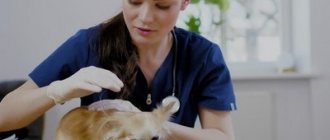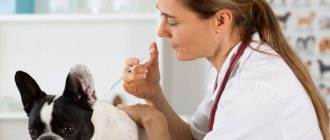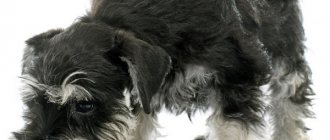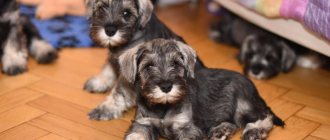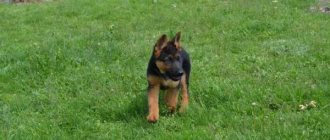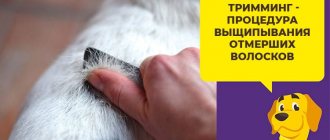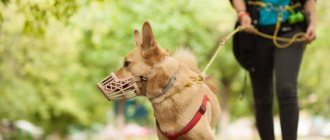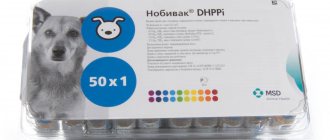Main characteristics
| Breed parameters | |
| Country of origin: | Germany |
| Weight of the breed: | males: 5.5-9 kg, females: 5.5-8.5 kg |
| Height at withers: | males: 30-36 cm, females: 30-36 cm |
| Temperament: | active |
| Wool: | average |
| Role in human life: | companion, watchdog, hunting |
The Miniature Schnauzer is a versatile dog that is equally good as a hunter, watchman, companion and friend. This breed is always in a good mood, its energy is off the charts. Miniatures are among the ten most sought after dogs in the world.
Trimming and cutting techniques. Grooming Standards
Table 1. Miniature Schnauzer: breed standard
| Parameter | Description |
| Head | Oval, slightly extended forward. The forehead is not protruding, there are no wrinkles |
| Eyes | Small, oval-shaped, dark in color, do not mow. Tight eyelids |
| Ears | Soft. According to the standard, they are docked and stand in a triangle |
| Neck | Powerful, not elongated |
| Breast | Medium width, oval. It bends at the bottom |
| Front legs | Straight, have a small distance between each other. The collarbone is straight on all sides. The shoulder blade is oblique and moves back. The shoulder is athletic. The angle of contact with the blade is 95/105 degrees. |
| Hind legs | When viewed from the side, they are mowed, from behind - they are not narrowly located, synchronous. The thigh is wide and of medium length. The knee is not twisted and does not go inward. The position of the limbs is “at the start”. The lower leg is powerful and strong |
| Wool | Wire-like, dense, similar undercoat |
| Color | Black/dark gray with tan/white/black with silver marks. Let's say ash and silver with off-white. A dark mask is required in all colors |
| Weight | Around 6 kg |
| Height | Does not exceed 35 cm |
A dark mask is mandatory for every Miniature Schnauzer.
Culling
Any deviation from the following points shall indicate a deficiency. Among the special ones are:
- The head is oval shaped;
- The presence of folds in the forehead area;
- Sharp muzzle, shortened;
- Straight bite;
- Extending cheek bones;
- Ears that are not parallel;
- Light, large/small eyes;
- Suspender/folds in the throat area;
- Back with a hump;
- The upper part of the neck is narrow;
- Beveled back;
- Tail like a hare's;
- Excessively long limbs;
- Soft wool with curls;
- Chocolate-colored undercoat;
- Black saddle;
- Color “black and silver” - the markings on the chest are not separated;
- The height at the withers deviates from the norm by more than 10 mm.
Severe defects include short legs and loose build. Also considered a defect is a “bitch in male type”, twisted elbows or hind legs. An elongated shin and short metatarsals are also the basis for such a mark.
Cowardice and suspicion are considered vices on a par with flaws in appearance
Disqualifying defects include deformities of any kind, lack of breed, improper bite and anything related to the jaw. They also look at cowardice, aggression, and malice. Attention is drawn to the dog's irritability and excessive suspicion.
We suggest you read: Which sleeping pill is better for cats: types and use at home
The wool is trimmed using special combs, knives and trimming stones. For better adhesion to the fur, do not bathe the dog under any circumstances! Also, experienced professionals usually use special trimming powders, and if they are not available, then baby powder or talc.
In order for the haircut to be even and neat, the procedure must be carried out only against the direction of hair growth - unlike plucking, which is carried out in the direction of hair growth!
Trimming is performed with the thumb of the right hand, which presses the fur to the knife, while the left hand holds the skin, because the hair is removed with a sharp jerk and in small tufts. Pinching is carried out exclusively in the direction of hair growth. This technique removes dead hairs and undercoat; the remaining fur is removed using a machine.
After the procedure, the skin in the treated area remains bare, so if it is not warm outside, the dog is dressed in special clothing that protects against hypothermia.
The groomer begins the procedure by pre-combing the dog. The trimming procedure is carried out from top to bottom, starting from the back of the head and ending with the tail. The area of the neck (on the sides and top), back, sides to the lower part of the chest is trimmed, leaving a dewlap at the bottom. The area from the shoulder blades to the elbows, from the hip to the hocks, as well as the upper part of the tail is pinched.
The dog's haircut is carried out after trimming is completed. Areas that have not been trimmed can be trimmed: the front of the chest and neck, under the tail, head, inner abdomen and thighs. Hair in this area can also be easily removed by plucking, but this can cause pain and discomfort for the animal, so scissors must be used.
- The hair around the ears is trimmed, and the hairs inside the ears are carefully plucked out.
- The dog's forehead is trimmed and hairs are removed from the occipital protuberance to the eyebrows.
- The bangs are combed towards the nose, creating a triangle. The width of the bangs should be less than the width of the forehead at the base of the triangle.
- The eyes must be opened to the side, but not too much. (The dog's head should be similar in shape to a rectangle)
- The hair is cut short from the tip of the nose to eye level
- The cheek area is trimmed from bottom to top, from the lips to the outer corner of the eye.
- The beard is combed forward and aligned along an oblique line, as well as the mustache.
- The neck and throat area is cut very short
- The bottom of the tail is cut short.
- The inner thighs are trimmed.
- The genital area and abdomen are also shaved using a clipper or trimmed with scissors.
- In the abdominal area, the fur from the chest is smoothly aligned.
- The hairs on the paws must be combed upward and trimmed using scissors. All unsightly protruding hairs on the bends of the joints are cut off.
- The area around the paws is trimmed, thereby exposing the claws. Upon completion of the haircut, the appearance of the limbs should resemble columns.
If the dog needs to be prepared for a show, then trimming must be done 8-10 weeks before the event. For schnauzers with slow-growing coats, trimming can be done 3 months before the show.
Also, 2 weeks before the exhibition, it is necessary to take the dog for a haircut, where the master will re-trim the face, neck, paws, shave the groin area and also prepare the final image for the exhibition. This is the final stage of preparation for the exhibition, which affects the evaluation of the dog by the judges, because the discrepancy between the pet’s coat and the exhibition standards can lead to punishment in the form of a reduction in points and even disqualification.
History of the breed
The historical homeland of small schnauzers is Germany. Presumably they descended from German Pinschers, which is why they are sometimes called Wirehaired Pinschers.
In ancient times, these dogs were famous for their ability to destroy rats and mice. They also served as guards and watchmen. During the formation of the breed, there were smooth-haired and wire-haired puppies. Somewhat later they began to be separated, the smooth-haired ones continued to be called pinschers, and the puppies with incomprehensible hair were simply called rat-catchers. Over time, the name Schnauzers was assigned to them, which means muzzle.
The main feature of those Schnauzers, just like modern ones, is the expressive head in the form of a rectangle with a beard.
Local dog breeders became interested in the new breed. As a result of selection and selection, funny miniature individuals with a lion's heart appeared, which were called miniature schnauzers. Translated from German, “zwerg” means “gnome”.
There are rumors that not only pinschers, but also affenpinschers, poodles and even spitzes took part in the appearance of small schnauzers. This is due to the fact that the first miniature schnauzers were exclusively black in color.
The main goal of the breeders of those times was the intention to breed small pets distinguished by great endurance, courage and unpretentiousness. They could live in small apartments and thrived in spacious farmlands. The main initiator of the emergence of the new breed was J. Bertha, a great connoisseur of schnauzers and pinschers.
In 1902, the first breeding book was published, in which 14 individuals of miniature schnauzers found their niche. The official representative of this breed is a male named Liliput.
In the 30s, the miniature population was at the peak of popularity, and not only in Europe, but also overseas. Bearded babies appeared in the USSR only in 1974; they were mainly imported from Czechoslovakia. Zwegschnauzers are still used today as the best and most unpretentious service dogs.
Vaccinations for miniature schnauzer puppies scheme
Swarovski wrote:
Please tell us about vaccinations. different information from different people.
What if you sit down and read?
Vaccination of dogs. Puppy vaccination schedule. Vaccinations. How to protect your pet from dangerous infections. Mechanism of action of the vaccine. The scheme and rules for vaccination of puppies, the formation of immunity, and what you need to know about vaccines Vaccination of dogs Why do you need to vaccinate puppies
It has long been noted that after suffering from any infection, animals become resistant to re-infection. This resistance is due to the formation of immunity.
The immunity acquired by the body as a result of illness is called active acquired immunity. It is caused by the synthesis in the body of specific lymphocytes and antibodies, which, upon repeated encounter with the infectious agent (antigen), destroy it, preventing it from causing harm to the body. Antibodies to various pathogens can remain in the body from several weeks to many years, providing it with long-term protection against the disease. The same immunity occurs as a result of vaccination of dogs.
The purpose of vaccination is to create active immunity, preventing the animal from becoming ill. Vaccines contain weakened or killed viruses and bacteria that are unable to cause overt disease in an animal, but provide immunity due to the antigens they contain. What you need to know about dog vaccines
Today, our market is replete with various vaccines and it is easy for the average person to get lost in this diversity, so let’s figure out how these vaccines differ.
There are so-called mono-vaccines (against one disease) and complex vaccines containing antigens of several different infections at once.
Currently, complex vaccines have been developed for dogs, including the most common and dangerous infections, primarily canine distemper, parvovirus enteritis, adenoviral hepatitis and rhinotracheitis, leptospirosis and rabies.
Further, vaccines can be killed or live. Killed vaccines are created from completely neutralized (killed) microorganisms. Such vaccines are not capable of causing disease even in weakened dogs. Immunity from the administration of killed vaccines is less durable and intense compared to live vaccines.
Live vaccines are created from specially grown, highly weakened strains of pathogens; they cause a mild (subclinical) infection, ensuring the formation of the most intense and lasting immunity in dogs.
Well, it remains to be said that vaccines differ in the quantitative content of viruses or bacteria in them (antigen titer). The higher the antigen titer in the vaccine, the more intense the immunity is formed after its administration, and the greater the likelihood of the appearance of symptoms of the disease and the clinical development of infection when a live vaccine is administered (especially to weakened dogs).
We recommend using high-quality vaccines from reputable manufacturers that have stood the test of time for vaccinating dogs. These are primarily vaccines from Nobivak and Eurikan. When are puppies vaccinated?
The goal of vaccination is to create active vaccine immunity in puppies at the earliest possible age, however, in babies, maternal antibodies destroy vaccine strains, preventing the development of their own, active immunity.
In relation to most diseases, the level of maternal antibodies decreases in puppies by the age of 9 - 12 weeks. It is during this period that dogs are usually vaccinated. Standard vaccination schedule for dogs and puppies
The vaccination schedule for puppies includes the first vaccination at 8 - 9 weeks of age and a booster vaccination at 12 weeks. At an earlier age, the formation of immunity is hampered by the high content of antibodies in the puppy’s blood, which he received from his mother’s colostrum in the first days of life. Puppies' antibody levels gradually decline and they may become susceptible to infections between 6 and 12 weeks of age. Since the pathogens included in vaccines are less aggressive than natural forms, an immune response to the vaccine can be formed in a puppy only at a lower level of antibodies, i.e. at a later date: 8 – 12 weeks.
Stable immunity to infections is formed only 10–14 days after the vaccine is administered, and during this period the puppy’s body is weakened and more sensitive to natural infection. For vaccines that require repeated administration during primary vaccination, COMPLETE immunity to infections appears after 14 days from the date of REVACCINATION, i.e. two weeks after the second dose of the vaccine.
Subsequently, to maintain immunity, dogs are revaccinated annually.
Dogs are vaccinated against rabies starting from 12 weeks of age, the vaccination is done once, and then an annual revaccination is carried out.
Considering the fact that there is an immune gap in the life of a puppy during a period when maternal immunity no longer provides protection and the vaccine immunity has not yet developed, it is necessary to protect the puppy from infection until the end of vaccination. Puppies should not be allowed to come into contact with possible sources of infection; in addition, they should be protected from overwork, stress and hypothermia. A complete, balanced diet, enriched with vitamins and minerals, is also important. After vaccination, for at least 10 days, it is advisable not to expose the puppy to great physical exertion, hypothermia and overheating, long and tedious transportation, as well as contact with other dogs. Early vaccination of puppies
Standard
The Miniature Schnauzer is a stocky, muscular and strong dog. The somewhat stern look that his shaggy eyebrows and goatee give him goes well with his short stature. The body is compact, the back is straight, inclined from the withers to the tail, the loin is short, the chest is powerful, extending in an arc to the groin, forming a beautiful line when the dog is standing. The unusual physique helps the dog develop very high speed.
The neck is medium, muscular, with a slight arch. The head is in harmony with the body, in the form of a modified wedge, tapering towards the nose. Strong skull, without occipital protuberance. The forehead is flattened, with a clear transition from the nose to the forehead. The nose is jet black, with wide nostrils. Powerful jaw, scissor bite, teeth without yellowness, strong, not extending beyond the boundaries of the row. The lips fit snugly to the jaw, without sagging at the corners.
The ears are triangular, set high, bent a quarter towards the temples. The lower edges of the ear are slightly adjacent to the cheekbones. The eyes are oval, small, curious, dark in color. The eyelids are dry, tightly fitting to the eyes.
Limbs are strong and muscular. The front ones are longer than the back ones, the elbow joints do not protrude. The fingers are short, the paws are rounded, similar to those of a cat. The tail is high and previously docked. The coat is hard, thick, with a dense undercoat. The movements are smooth, energetic, light. The running is clear, strength and power are felt in the movements.
Acceptable colors: black, silver-black, gray, white. In the Russian Federation, chocolate and tan is also approved.
Disqualifying signs:
- Round massive skull.
- Long pointed or very short muzzle.
- Elongated, arched back.
- Long coat.
- Malocclusion.
- Cowardice, timidity, aggression.
Character and temperament
The Miniature Schnauzer is often called the "little big dog." This is because a miniature body contains a serious character, fortitude and considerable physical fitness. Miniatures have a reinforced concrete psyche, it is difficult to anger them, they have an instant reaction to the slightest changes and there is absolutely no feeling of fear. Such a guard and defender is not to be trifled with.
The guard qualities of the Miniature Schnauzer are genetically determined; they manifest themselves from puppyhood. This is an excellent protector of home, family, even strategically important objects. A properly raised dog first warns of danger with a loud bark, and if necessary, without hesitation he will rush to attack. The consequences of his teeth can be quite significant.
A small schnauzer is a hunter by nature, so it will not be friends with small domestic animals. Be suspicious of cats, especially strangers.
When you meet a miniature schnauzer on the street, you might think that he is a calm and measured dog. However, this is not the case; they are distinguished by their cheerful disposition, activity and playfulness. She will be happy to take part in children's games, keep company during her morning jog and spend time with her family outside the city. Such a dog is cunning, crafty and resourceful. But along with this, he is distinguished by excessive kindness and is touchingly devoted to his people.
Education and training
You need to start training your little schnauzer from an early age, otherwise you risk getting a capricious and stupidly barking pet. Miniatures are very temperamental, impetuous, ready to fight at any moment, and they also love to bark for no reason. All this needs to be controlled and kept in check.
The main thing to pay attention to is obedience. The pet must understand from the first word what they want from him and carry out the command received. They need authoritarian upbringing, and under no circumstances should they show aggression or hit the dog.
You need to quickly stop any attempts in the wrong direction on the part of your pet, focusing on the vocal tone. You can also shake the baby slightly by grabbing it by the withers. If in childhood a dog is not weaned from biting, stealing from the table, and the habit of grabbing everything that is in the wrong place, then in adulthood it will never be retrained.
This breed is distinguished by its intelligence and hard work; the puppies can be trained fairly quickly and do an excellent job of following commands of any complexity. If you approach the educational process correctly, then in the future you will get an ideal pet that understands its owner at a glance. Well-mannered dogs will never show aggression, will not get into a fight, will not bark loudly at everyone around them, and will never go out of control.
Review of popular vaccines
Currently, there are quite a large number of vaccines from various manufacturers on the market. Let's look at the most popular of them.
Nobivak
The Dutch vaccine manufacturer proposes to use Nobivak for vaccinations. This is a high-quality vaccine with a relatively inexpensive cost. There are several types of Nobivak.
Nobivac DHPPI
Protects the animal from diseases such as leptospirosis, parainfluenza, rabies, canine distemper, infectious hepatitis, parvovirus enteritis. Administered to puppies from 2.5 months of age and adult dogs. Puppies are vaccinated at 10 weeks, then 1 month later, then annually.
Nobivac L
Eliminates infection of dogs with leptospirosis. The drug is administered to puppies from 2 months of age, then after 21 days the procedure is repeated again.
Nobivac KC
Prevents the development of bordetellosis and parainfluenza. Available in the form of a suspension for oral administration. Suitable for newborn puppies and pregnant bitches.
Nobivac R
Effective against rabies. Injected into the muscle or subcutaneously. Provides the dog with lasting immunity from the disease for 3 years.
Nobivac RL
A complex drug that prevents infection with rabies and leptospirosis. Animals over one year of age are subject to vaccination with this drug.
Nobivac DHP
Complex vaccine against hepatitis (infectious), distemper and parvovirus enteritis. Performed on puppies who have reached 2 months of age, revaccination – after 21 days.
Rabisin
A French-made vaccine with a monovalent effect forms a stable protective reaction against the rabies virus. The drug is well tolerated by animals, but is incompatible with other vaccines. The period of validity of the vaccine is 1 year.
Dipentavak
The drug is of domestic origin. A polyvalent remedy against adenovirus, parvovirus, leptospirosis and infectious hepatitis.
Biovac
Live vaccine of domestic production. It has several types: Biovac – L (leptospirosis); Biovac – D (canine plague); Biovac – P (parvovirus); Biovac – DPA (distemper, adenovirus, parvovirus, infectious hepatitis); Biovac – PA (parvovirus enteritis, adenovirus); Biovac – DPAL (plague, adenovirus, parvovirus, leptospirosis). Raising a puppy must be approached with full responsibility. It is important not only to provide the animal with daily walks, quality food, love and care, but also to do everything possible to ensure that the pet grows up healthy. Timely vaccination will help the dog owner protect his four-legged friend from most serious and dangerous diseases.
Maintenance and care
There is a saying, small dog, small troubles. Regarding the miniature, everything is somewhat different. Caring for them, although not particularly difficult, does take time, especially when it comes to the pet’s appearance.
Puppy in the house. You need to prepare in advance for the arrival of a four-legged baby. First of all, you need to remove all small objects within his reach. Little miniatures love to chew shoes, they will easily turn over a floor flower, become interested in a rug, and try children's toys. To avoid troubles, it is better to remove all this for a while. In addition, take care of the wires; the puppy will also definitely reach them.
The little fidget will have to be fed 4 times a day; as the dog grows older, it is switched to a twice-a-day diet. Many succumb to the bottomless questioning eyes and feed the adult more often, this is strictly prohibited, the pet must be in shape.
Food from the master's table should not be in the miniature's bowl.
Your pet's daily diet should include only proper and nutritious foods: meat (beef, poultry, rabbit, turkey, lean pork), certain cereals, dairy products, vegetables, vitamins and minerals. Among ready-made industrial feeds, preference should be given to the super premium or holistic line for small and active breeds.
Diseases
Miniature schnauzers are quite strong animals that, with proper care, practically do not get sick. However, they are still susceptible to some diseases:
- Glaucoma.
- Cataract.
- Food allergies.
- Dermatitis.
- Benign and malignant neoplasms.
- Skin diseases.
- Infectious diseases.
The good health of your pet is the result of proper care, nutrition and timely vaccinations, as well as the absence of stressful situations.
What diseases require annual vaccination?
An adult dog must be vaccinated annually, but if the animal was adopted as an adult and there is no data on its vaccinations, vaccination is done as soon as possible (provided that the animal is healthy).
Repeated administration of the vaccine to an adult dog is carried out after 1 month and then according to the schedule (once a year). There are situations when an adult animal is vaccinated, but it was vaccinated not so long ago. Repeated administration of the vaccine can cause serious complications in the dog, so if the animal is picked up from the street, it is better to test the dog’s blood for the presence of antibodies.
Veterinarians recommend vaccinating older dogs once every 3 years, since any vaccination is a serious burden on the body. It is not advisable to vaccinate older dogs with chronic diseases, the only exception being vaccination against rabies.
Healthy adult dogs are vaccinated annually against the following diseases:
Parvovirus enteritis. The disease is widespread and kills many dogs. The virus has a destructive effect on the liver, intestines and pancreas of the animal. Parvovirus is especially dangerous for puppies, as it quickly leads to dehydration and death;
Rabies. A terrible viral disease of all warm-blooded animals, including humans. As a result of the disease, the central nervous system is destroyed and 100% death occurs. Veterinary legislation in almost all countries requires every dog owner to have an annual vaccination against a fatal disease;
Parainfluenza. Characterized by an inflammatory process of the upper respiratory tract. Parainfluenza does not pose a mortal threat to the animal, but often results in complications in the form of pneumonia, so the best option to avoid infection is vaccination;
Viral hepatitis. In young pets, the disease often occurs in a fulminant form and the animals often die; in mature dogs, the disease mainly becomes chronic;
Plague of carnivores. A highly contagious disease that is difficult to treat. In most cases of distemper infection, the four-legged friend dies from damage to the central nervous system;
Adenovirus. An infectious disease accompanied by digestive disorders and cough. The disease is dangerous due to complications such as dehydration and the development of pneumonia;
Leptospirosis. An infectious disease of many animals, as well as humans. Accompanied by damage to the digestive organs and jaundice.
Coronavirus. Another viral infection that causes enteritis in animals.
How to choose a puppy?
Choosing a puppy is always difficult, especially if you are not entirely sure which breed to choose. If you decide to opt for a bearded baby, first familiarize yourself with the appearance of the future pet in the photo and see what an adult looks like. Also study the pros and cons of the breed, decide whether you want a boy or a girl. Girls, as a rule, are taken as studs; if they are pets, then only castrated. Find out how long they live and whether care is difficult. In addition, the baby will have to be raised.
Regardless of the purpose of purchasing a miniature dog, go to a professional nursery with a good reputation for your future family member. In such places, the purebred puppy will be documented. In addition, you will be able to independently evaluate the appearance of parents and children, and view the results of testing for genetic diseases. Price: 400-1200 USD And remember, you need to choose your friend with your heart!
Consequences of vaccination
Usually a completely healthy animal tolerates vaccinations without complications, but sometimes after vaccination the following allergic consequences may occur:
1. Severe drooling. 2. Diarrhea and vomiting. 3. Increase in body temperature. 4. Pallor of visible mucous membranes. 5. Shortness of breath. 6. Redness of the skin.
If such signs appear, you should immediately contact the specialist who performed the vaccination. The treatment for an allergic reaction is the use of an antihistamine.
In some cases, a lump may form at the injection site. A small lump does not pose a danger to the animal and, as a rule, resolves within a short time. But if the lump does not go away for a long time, has increased in volume and becomes hot, this is a reason to urgently consult a doctor. These symptoms indicate the development of an inflammatory process in the subcutaneous tissue, and this condition requires only surgical intervention.


